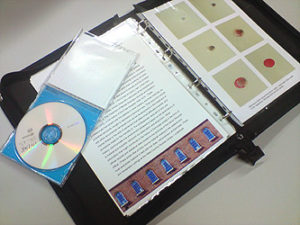 Guest artist/author: Stacey Cornelius
Guest artist/author: Stacey Cornelius
Recently, I had the opporunity to help a painter put together a new portfolio to take to galleries. She was going on a trip and decided to look for a few new venues while she was away.
This artist is a very good writer, so I made only a few edits to her artist’s statement. She had her CV (curriculum vitae) nicely formatted, a couple of reviews, a business card, and some wonderful reproductions of her work arranged in an attractive folder.
She also had a CD of her paintings, with her name neatly printed on the disc, visible through the clear jewel case.
That case, if used properly, was worth its weight in gold.
I suggested she treat the disc like a music CD, adding an insert with an image on the front, and her own version of liner notes inside. If the CD got separated from the rest of the portfolio, it could easily stand on its own as a mini portfolio.
She thought it over for a moment, which gave me the chance to reinforce the point.
“When you’re promoting your work, do everything with intent.”
Bingo.
She loved the idea and was excited about putting the finishing touches on her portfolio.
Even if the CD remained safely in the folder, paying attention to details makes a difference. That extra bit of professionalism enhances your first impression, and will help establish your reputation as you build your career.
There was one other small thing. One of the reviews was taken from a newspaper. The photocopied piece wasn’t centered on the page, and there was one small ragged edge on the clipping. I pulled it out and began to explain.
I didn’t have to finish the sentence.
She hadn’t noticed, and expressed surprise, because she’s normally more careful. She nodded and grinned, repeating her new mantra.
When you’re anxious to get your work into public view, it’s easy to forget about small details. But everything you put in someone’s hands, or in front of someone’s eyes, makes a statement about you. Not just the slides of your work, or the images you burned onto your CD, but also the way you present it.
Do everything with intent. It shows you at your very best.
___________________________________________
Guest author, Stacey Cornelius is a raving idealist, idea junkie, and creative entrepreneur with a Fine Art degree. Her website, The Studio Source helps you manage the business side of creativity.
***









Bet the gallery takes 20-30 seconds (if that) to flip through to the photos of art and does not read or look at the rest.
The better question regarding the effectiveness of the portfolio: Did it get you in the art gallery?
The gallery owner usually only has three thoughts when looking at a new artist:
1. Does the art fit with the rest of the art in my gallery? (Clown cartoon art does not fit in a conservative Cowboy art gallery)
2. Will the art sell to my customers?
3. Is the art priced high enough that it sells and I make a healthy 50%?
Hi Sandra.
Thanks for sharing your thoughts – and believe it or not, I agree with what you have to say! Most galleries make a decision based on whether or not the art is a good fit, if it is professionally executed, if it is saleable, and if they believe in it.
And yes, most galleries make quick decisions when viewing a porfolio. That said, it is always better to put your ‘best foot forward’ and stand out from the rest. A professional portfolio will help the artist, especially if the artist doesn’t have any previous connection or affiliation to the target gallery. Also, galleries get hundreds of submissions a year. A pro presentaion will out-shine the others in that stack of portfolios on the director’s desk.
It is always better to have more ammunition, than not enough!
Thanks again for your comment – Lori 🙂
Hi Lori,
Always love your useful arttips!! Also thanks for making it possible for others to share their tips as well. I really appreciate it!!!
For all you do for the artists community I have just tagged you. Please stop by my blog tomorrow morning and read about it, and follow the trend if you can…
Best always,
Corina
This is a very helpful article. I find that many people really underestimate the effectiveness of this kind of preparation for any sales process. It is particularly important for the artist because it is a potent way to distinguish yourself from competitors.
The only comment I would add is that laying the groundwork for your presentation with the gallery owner is sometimes as important as the preparation for your actual presentation. My wife is a gallery owner and receives regular visits from artists with their work.`Several of the artists have paid visits to her shop prior to ever showing her any work – just to get a sense of the place and actually meet my wife on a more social level Then, on the second or third visit , they mention that they are an artist who produces work that might fit in her gallery. The meeting that follows this approach is usually a pleasant and successful one.
I find this approach to be effective in several ways. First, the artist has a chance to get a sense of the gallery and can speak more forcefully about why their work might fit. I think it also makes you a more comfortable speaker when you are in a place that you have visited several times. For my wife’s part, she feels more comfortable because she has met the artist before and doesn’t feel like she is sitting with a stranger.
Bob
Thank you for your valuable comment, Bob. You insight is very helpful. I agree with your suggestion and have had luck with that approach in the past myself. It is good you get the inside scoop from a gallery director’s perspective.
I appreciate you sharing-
Lori 🙂
Lori,
Great article as usual and do so appreciate all the hard work put into your site.
Bob, I thought you made a very important point. We can’t visit all the galleries where we desire to have our work represented, but if you can……..it is so important to meet the owners or representatives there and get a “feel’ for their intent and purpose. I take time out regularly to meet not only other artists in their studios for my blog post, but to get an idea what an idea what a gallery wants to sell and how they go about it. Many here in Asheville, NC have different approaches to selling. Some galleries upbeat, casual and others more formal, etc. Some artists many think, I don’t have the time to do that. However, I have been taking time to connect with the art community as a whole and the process of showing and selling art, which is SO very important. This way we can value and appreciate each participant’s process in the art field. The problem is when you have a disconnect between galleries and artists, if you don’t connect (find the right fit) the success won’t happened for both parties. Know each other well, the gallery, the gallery owners, and artist. And naturally, the artist has to be well prepared and professional, just like in any business situation. You are marketing and selling a product, like it or not.
Allison Reece/Artist
Wacky Artsy Asheville, NC
Hi Allison,
Great to see you on my blog and I apologize for the belated response…I have been painting for shows. Thank you for the nice words and your insightful comment. I totally agree with you about the ‘disconnect’ that can happen when artist and gallery fail to communicate.
Hope to see you here again-
Lori 🙂